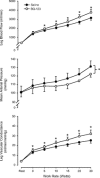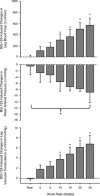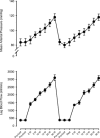Taming the "sleeping giant": the role of endothelin-1 in the regulation of skeletal muscle blood flow and arterial blood pressure during exercise
- PMID: 23103494
- PMCID: PMC4838135
- DOI: 10.1152/ajpheart.00603.2012
Taming the "sleeping giant": the role of endothelin-1 in the regulation of skeletal muscle blood flow and arterial blood pressure during exercise
Abstract
The cardiovascular response to exercise is governed by a combination of vasodilating and vasoconstricting influences that optimize exercising muscle perfusion while protecting mean arterial pressure (MAP). The degree to which endogenous endothelin (ET)-1, the body's most potent vasoconstrictor, participates in this response is unknown. Thus, in eight young (24 ± 2 yr), healthy volunteers, we examined leg blood flow, MAP, tissue oxygenation, heart rate, leg arterial-venous O(2) difference, leg O(2) consumption, pH, and net ET-1 and lactate release at rest and during knee extensor exercise (0, 5, 10, 15, 20, and 30 W) before and after an intra-arterial infusion of BQ-123 [ET subtype A (ET(A)) receptor antagonist]. At rest, BQ-123 did not evoke a change in leg blood flow or MAP. During exercise, net ET-1 release across the exercising leg increased approximately threefold. BQ-123 increased leg blood flow by ~20% across all work rates (changes of 113 ± 76, 176 ± 83, 304 ± 108, 364 ± 130, 502 ± 117, and 570 ± 178 ml/min at 0, 5, 10, 15, 20, and 30 W, respectively) and attenuated the exercise-induced increase in MAP by ~6%. The increase in leg blood flow was accompanied by a ~9% increase in leg O(2) consumption with an unchanged arterial-venous O(2) difference and deoxyhemoglobin, suggesting a decline in intramuscular efficiency after ET(A) receptor blockade. Together, these findings identify a significant role of the ET-1 pathway in the cardiovascular response to exercise, implicating vasoconstriction via the ET(A) receptor as an important mechanism for both the restraint of blood flow in the exercising limb and maintenance of MAP in healthy, young adults.
Figures




References
-
- Andersen P, Adams RP, Sjogaard G, Thorboe A, Saltin B. Dynamic knee extension as model for study of isolated exercising muscle in humans. J Appl Physiol 59: 1647–1653, 1985. - PubMed
-
- Arai H, Hori S, Aramori I, Ohkubo H, Nakanishi S. Cloning and expression of a cDNA encoding an endothelin receptor. Nature 348: 730–732, 1990. - PubMed
-
- Barden J, Lawrenson L, Poole JG, Kim J, Wray DW, Bailey DM, Richardson RS. Limitations to vasodilatory capacity and V̇o2 max in trained human skeletal muscle. Am J Physiol Heart Circ Physiol 292: H2491–H2497, 2007. - PubMed
Publication types
MeSH terms
Substances
Grants and funding
LinkOut - more resources
Full Text Sources
Other Literature Sources
Medical

